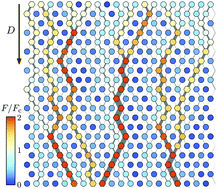Force transmission and the order parameter of shear thickening
Abstract
The origin of the abrupt shear thickening observed in some dense suspensions has been recently argued to be a transition from frictionless (lubricated) to frictional interactions between immersed particles. The Wyart–Cates rheological model, built on this scenario, introduced the concept of the fraction of frictional contacts f as the relevant order parameter for the shear thickening transition. Central to the model is the “equation-of-state” relating f to the applied stress σ, which is directly linked to the distribution of the normal components of non-hydrodynamic interparticle forces. Here, we develop a model for this force distribution, based on the so-called q-model, which we borrow from granular physics. This model explains the known f(σ) in the simple case of sphere contacts displaying only sliding friction, but also predicts strong deviation from this “usual” form when stronger kinds of constraints are applied on the relative motion. We verify these predictions in the case of contacts with rolling friction, in particular a broadening of the stress range over which shear thickening occurs. We finally discuss how a similar approach can be followed to predict f(σ) in systems with other variations from the canonical system of monodisperse spheres with sliding friction, in particular the case of large bidispersity.



 Please wait while we load your content...
Please wait while we load your content...
